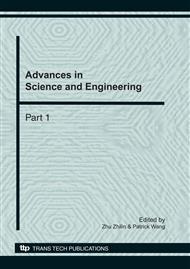[1]
Zhang, Y., The urgent demand of society risk assessment with social development. China Security (2006), 51-52.
Google Scholar
[2]
Zhenyu Wang, Yaping Wang, Ke Li, Study on joint operations effectiveness evaluation based on combat simulation. Military Operations Research and System Engineering. Vol. 20 (2005), 62-66.
Google Scholar
[3]
C.L. Smith, The development of a Security Systems Research and Test Laboratory at University. Proceedings of 2004 IEEE International Carnahan Conference on Security Technology, (2004), 111-115.
DOI: 10.1109/ccst.2004.1405378
Google Scholar
[4]
Gregory Howard Graves, Analytical Foundations of Physical Security System Assessment: [dissertation]. Texas A&M University. (2006).
Google Scholar
[5]
Sandia National Laboratories, A risk assessment methodology (RAM) for physical security. White paper. (2006).
Google Scholar
[6]
Tang Dan, Yin Xiandong, Fang Ni, Guo Cao. Physical Protection System and Vulnerability Analysis Program in China. (2001), 16-26.
Google Scholar
[7]
U.S. DOE, EASI estimate of adversary sequence interruption on an IBM PC. SAND Report851105. (1985), 1-63.
Google Scholar
[8]
Matter, J. C, SAVI: A PC-Based Vulnerability Assessment Program. SAND88-1279, (1988).
Google Scholar
[9]
L. R. Doyon, Stochastic modeling of facility security-systems for analytical solutions. Computers & Industrial Engineering. Vol. 5, No. 2 (1981), 127–138.
DOI: 10.1016/0360-8352(81)90020-6
Google Scholar
[10]
M. J. Hicks, M. S. Snell, J. S. Sandoval, and C. S. Potter, Cost and performance analysis of physical protection systems–a case study, in Proceedings 32nd Annual 1998 International Carnahan Conference on Security Technology, Alexandria, Virginia, (1998).
DOI: 10.1109/ccst.1998.723770
Google Scholar
[11]
J. E. Kobza and S. H. Jacobson, Probability models for access security system architectures. The Journal of the Operational Research Society, Vol. 48, No. 3 (1997), 255–263.
DOI: 10.1057/palgrave.jors.2600331
Google Scholar
[12]
R. J. Fischer and G. Green, Introduction to Security, 7th Edition, Elsevier, Boston, (2004).
Google Scholar
[13]
M. L. Garcia, The Design and Evaluation of Physical Protection Systems, Butterworth - Heinemann: Boston, (2001).
Google Scholar
[14]
Zhihua Chen. The research and practice on the evaluation of effectiveness on security system. China Security. (2007), 16–20.
Google Scholar
[15]
Rongsheng Zhao, The design and development analytic software of physical protection system: [dissertation]. China Institute of Atomic Energy. (2003).
Google Scholar
[16]
Yahua Sun, Shiju Li, Bin Li, Quantitative evaluation of physical protection system in nuclear power plant. Engineering of Nuclear Power. Vol. 30. No. 1 (2009) 20-25.
Google Scholar
[17]
Shannon, C.E., A mathematical theory of communication. Bell System Technical Journal. Vol. 27 (1948), 379-423 and 623-656.
DOI: 10.1002/j.1538-7305.1948.tb00917.x
Google Scholar


